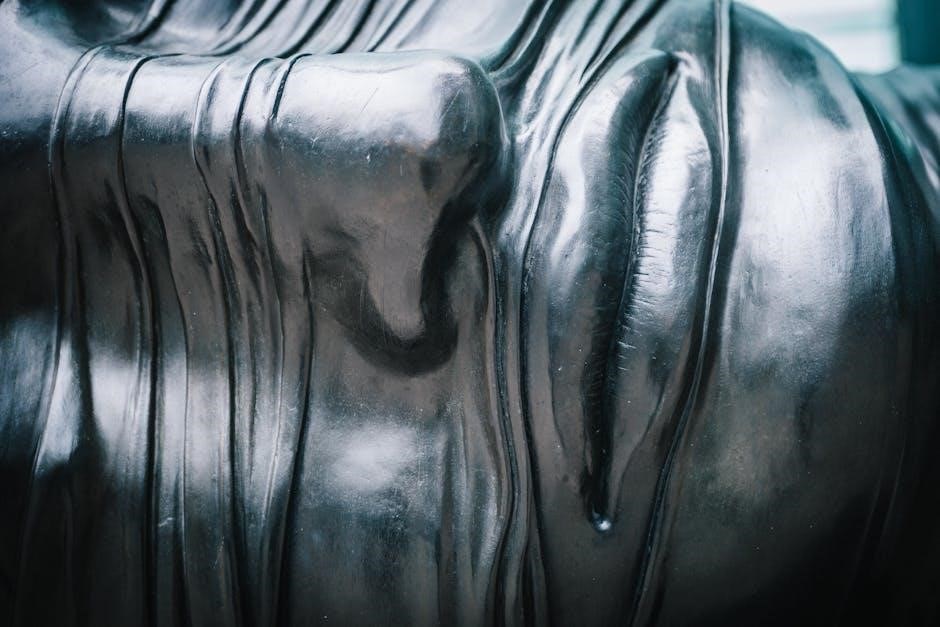
This guide provides comprehensive instructions for installing your Honeywell Pro 8000 thermostat. It covers everything from initial preparation and safety to Wi-Fi connectivity and troubleshooting. Follow these steps to ensure a seamless and successful installation of your new thermostat for optimal home climate control.
Preparation and Safety Precautions
Before commencing the installation of your Honeywell Pro 8000 thermostat, meticulous preparation and adherence to safety precautions are paramount. Begin by gathering all necessary tools and materials, ensuring they are readily accessible. Prior to any wiring work, always disconnect power to your heating and cooling system at the circuit breaker or fuse box to prevent electrical shock or equipment damage.
Carefully read and understand all instructions provided in this guide and the thermostat’s documentation. If you are not comfortable working with electrical wiring or HVAC systems, it is strongly recommended to consult a qualified and experienced technician. Identifying thermostat terminals correctly is vital for correct wiring of the Honeywell Pro 8000.
Exercise caution when handling tools and working around electrical components. Ensure the work area is well-lit and free from obstructions. Wear appropriate safety gear, such as safety glasses, to protect your eyes. Double-check all wiring connections before restoring power to the system. Improper wiring can lead to system malfunction, damage, or hazardous conditions.

If you are replacing an old thermostat, take a photo of the existing wiring configuration before disconnecting any wires. This will serve as a reference during the wiring process. By taking these preparatory steps and prioritizing safety, you can minimize risks and ensure a successful Honeywell Pro 8000 installation.
Identifying Thermostat Terminals (R, C, etc.)
Accurately identifying the thermostat terminals is crucial for the correct wiring of your Honeywell Pro 8000. Common terminals include R (system power), C (common wire), W (heat), Y (cool), and G (fan). Note the existing wiring configuration, photographing the old thermostat before disconnecting any wires.
The R terminal is typically connected to the secondary side of the system transformer, providing power to the thermostat. The C terminal, or common wire, is essential for providing a stable power source to the thermostat, especially for Wi-Fi models. Without a properly connected C wire, the thermostat may not function correctly.
For heating systems, the W terminal controls the heating components. The Y terminal is responsible for controlling the cooling components in air conditioning systems. The G terminal activates the fan, allowing for air circulation even when heating or cooling is not required.
In heat pump systems, additional terminals such as O or B may be present to control the changeover valve. If your system includes these, ensure they are correctly identified and connected according to your system’s configuration. Always refer to your HVAC system’s documentation for specific terminal designations to prevent wiring errors and potential system damage. Incorrect wiring can lead to inefficient operation or equipment failure.
Tools and Materials Needed for Installation

Before beginning the installation of your Honeywell Pro 8000 thermostat, gather all the necessary tools and materials to ensure a smooth and efficient process. Essential tools include a screwdriver set (both Phillips head and flathead), a wire stripper, a level, and a drill with a 7/32 drill bit for creating pilot holes in plaster or drywall.
In terms of materials, you will need the Honeywell Pro 8000 thermostat itself, the included mounting screws, and wall anchors if you are installing on drywall. It is also wise to have extra wire on hand, in case the existing thermostat wires are too short or damaged. Electrical tape is useful for insulating any exposed wire connections.
A voltage tester is highly recommended to ensure that the power to the HVAC system is turned off before you begin any wiring. This is crucial for safety and prevents electrical shock or damage to the equipment. Additionally, consider having a small flashlight or headlamp to help you see clearly in dimly lit areas.

Finally, a pencil and paper are useful for labeling wires and noting the existing thermostat wiring configuration. This will help you accurately connect the wires to the new thermostat.

Removing the Old Thermostat
Before you begin, ensure the power to your HVAC system is completely turned off at the circuit breaker to prevent any electrical hazards. Carefully remove the cover of your old thermostat, which is usually held in place by clips or screws. Once the cover is off, you will see the wiring connections.
Before disconnecting any wires, take a picture of the existing wiring configuration or carefully label each wire with a piece of tape indicating its terminal connection (e.g., R, W, Y, G, C). This step is crucial for correctly wiring the new Honeywell Pro 8000 thermostat.
Using a screwdriver, carefully disconnect each wire from the old thermostat. Be gentle to avoid damaging the wires. If the wires are brittle or frayed, consider stripping them back slightly to expose fresh wire.
Once all the wires are disconnected, remove the old thermostat’s baseplate from the wall. This is usually attached with screws. If using the same mounting holes, keep the screws. If not, you may need to use wall anchors for a secure fit.
With the old thermostat completely removed, you are now ready to prepare the wall for the new Honeywell Pro 8000 installation.
Wiring the Honeywell Pro 8000
With the old thermostat removed, carefully thread the wires through the opening in the Honeywell Pro 8000’s wallplate. Using the photo or labels you created earlier, begin connecting the wires to the corresponding terminals on the new thermostat’s base. Ensure each wire is securely fastened to its terminal.
Refer to the Honeywell Pro 8000’s wiring diagram in the installation manual for specific configurations. Common terminals include R (power), C (common), W (heat), Y (cooling), and G (fan). If you have a heat pump system, you may also have O/B terminals for the reversing valve. If your old thermostat had jumper wires, consult the Honeywell manual for proper handling.
Double-check that each wire is connected to the correct terminal and that the screws are tightened securely. Loose connections can cause malfunctions or damage to your HVAC system. Gently tug on each wire to ensure it is firmly in place.
If you encounter any unfamiliar wiring scenarios or are unsure about a connection, consult a qualified HVAC technician. Incorrect wiring can damage your equipment.
Once all the wires are connected and secured, proceed to mounting the thermostat wallplate to the wall.
Mounting the Thermostat Wallplate
After wiring the Honeywell Pro 8000, position the wallplate against the wall, ensuring the wires are neatly tucked through the opening. Use a level to verify the wallplate is straight before proceeding. Mark the locations for the mounting screws through the designated holes on the wallplate.
If you’re mounting on drywall, use the provided wall anchors. Drill pilot holes at the marked locations using a 7/32 drill bit for plaster, insert the anchors, and then align the wallplate with the anchors. If mounting on solid wood, you may not need anchors, but be sure to use appropriately sized screws.
Secure the wallplate to the wall using the provided mounting screws. Tighten the screws until the wallplate is firmly attached but avoid overtightening, which could damage the wall or the wallplate itself. Ensure the wallplate remains level during this process.
Once the wallplate is securely mounted, inspect it to confirm it’s flush against the wall and that there are no loose areas. This provides a stable base for attaching the thermostat.
With the wallplate firmly in place, you are ready to attach the Honeywell Pro 8000 thermostat.
Attaching the Thermostat to the Wallplate
With the wallplate securely mounted, carefully align the Honeywell Pro 8000 thermostat with the wallplate. Ensure that all the pins on the back of the thermostat line up correctly with the corresponding terminals on the wallplate. Gently push the thermostat onto the wallplate until it snaps firmly into place.
It’s important to avoid forcing the thermostat onto the wallplate. If you encounter resistance, double-check the alignment of the pins and terminals. Forcing it could damage the pins or the thermostat itself; You should hear a click, indicating that the thermostat is securely attached. Give the thermostat a light tug to confirm that it’s properly seated and won’t easily detach.
Once the thermostat is attached, inspect all sides to ensure a flush fit between the thermostat and the wallplate. If there are any gaps or misalignments, remove the thermostat and reattach it, paying close attention to the alignment. The thermostat should sit securely on the wallplate, providing a clean and professional appearance. After the thermostat is securely mounted, it is time to configure the installer setup menu.
Configuring the Installer Setup Menu
Accessing the Installer Setup Menu is crucial for tailoring the Honeywell Pro 8000 to your specific HVAC system. Typically, this involves pressing and holding a specific button combination (refer to your thermostat’s manual for exact instructions). Once in the menu, you’ll navigate using the up and down arrow keys, and select options with a designated button.
The Installer Setup Menu allows you to configure various parameters, including the system type (heat pump vs. conventional), fan control, temperature scale (Fahrenheit or Celsius), and cycle rates. Carefully review each setting to match your system’s requirements. Incorrect settings can lead to inefficient operation or even damage to your HVAC equipment.
It’s highly recommended to consult your HVAC system’s documentation to determine the correct settings for your specific setup. If you’re unsure about any setting, consider consulting a qualified HVAC technician. After configuring the installer setup menu, you must set the system type to either heat pump or conventional based on your HVAC system’s configuration.
Setting the System Type (Heat Pump vs. Conventional)
One of the most critical steps in configuring your Honeywell Pro 8000 is setting the system type. This determines how the thermostat controls your heating and cooling equipment. The two primary options are “Heat Pump” and “Conventional.”
A “Conventional” system typically involves a furnace for heating and a separate air conditioner for cooling. In this setup, the thermostat directly controls the furnace and air conditioner independently. A “Heat Pump” system, on the other hand, uses a heat pump for both heating and cooling. Heat pumps can reverse their operation to either extract heat from the outside air (even in cold temperatures) or expel heat to the outside.
Selecting the wrong system type can result in improper operation. For example, if you have a heat pump but configure the thermostat for a conventional system, the auxiliary heat might engage unnecessarily, leading to higher energy bills. Consult your HVAC system’s documentation or a qualified technician to determine the correct setting.
Connecting to Wi-Fi Network (if applicable)
If your Honeywell Pro 8000 model supports Wi-Fi connectivity, connecting it to your home network unlocks a range of smart features, including remote control via a smartphone app and integration with other smart home devices.
To begin, ensure your thermostat is powered on and has completed the initial setup. Navigate to the Wi-Fi settings menu on the thermostat’s display. The thermostat will then scan for available Wi-Fi networks in your area. Select your home network from the list and enter the correct password when prompted. It’s essential to ensure you have the correct password, as incorrect credentials will prevent the thermostat from connecting.
Once connected, the thermostat will display a confirmation message. You can then download the Honeywell Home app on your smartphone or tablet and follow the in-app instructions to register your thermostat and link it to your account. This allows you to control your thermostat from anywhere with an internet connection.
Testing the Thermostat Functionality
After completing the wiring and mounting, and configuring the system settings, it’s crucial to test the thermostat’s functionality to ensure it’s operating correctly. Begin by setting the thermostat to “Heat” mode and increase the setpoint temperature above the current room temperature. Verify that your heating system activates within a few minutes.
Next, switch the thermostat to “Cool” mode and lower the setpoint temperature below the current room temperature. Confirm that your air conditioning system starts up and begins cooling the space. It’s essential to listen for any unusual noises or malfunctions from your HVAC equipment during these tests.
Test the fan settings by switching the fan mode to “On” and “Auto.” In “On” mode, the fan should run continuously, while in “Auto” mode, it should only run when the heating or cooling system is active. If any of these tests fail, double-check your wiring connections and system configuration settings. Refer to the troubleshooting section for further assistance if needed.
Troubleshooting Common Installation Issues
Encountering issues during the installation of your Honeywell Pro 8000 is not uncommon. One frequent problem is the thermostat not powering on. Ensure the “C” wire (common wire) is correctly connected, as this provides the necessary power. If the display remains blank, check the breaker and transformer.
If the heating or cooling system doesn’t activate, verify the wiring matches your system type (heat pump or conventional). Incorrect wiring can prevent proper operation. Double-check the thermostat’s system settings in the installer menu to confirm they align with your HVAC system.
Another issue is the thermostat displaying incorrect temperature readings. Ensure the thermostat is not exposed to direct sunlight or drafts, which can affect its accuracy. Recalibrate the temperature sensor in the settings menu if necessary. For Wi-Fi connectivity problems, verify your network credentials and router compatibility. If problems persist, consult Honeywell’s support resources or a qualified HVAC technician for assistance.